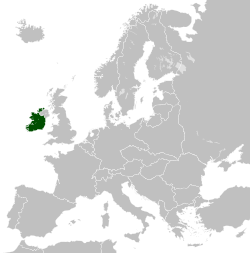
Back Ierse Vrystaat Afrikaans الدولة الأيرلندية الحرة Arabic Estáu Llibre Irlandés AST Azad İrland dövləti Azerbaijani Ірландская Свабодная дзяржава Byelorussian Ирландска свободна държава Bulgarian Estat Lliure d'Irlanda Catalan Irský svobodný stát Czech Gwladwriaeth Rydd Iwerddon Welsh Den irske fristat Danish
Irish Free State Saorstát Éireann (Irish) | |||||||||||
|---|---|---|---|---|---|---|---|---|---|---|---|
| 1922–1937 | |||||||||||
| Anthem: "Amhrán na bhFiann"[1] "The Soldiers' Song" | |||||||||||
 The Irish Free State (green) in 1929 | |||||||||||
| Status | British Dominion (1922–1931)[a]
Sovereign state (1931–1937)[b] | ||||||||||
| Capital and largest city | Dublin 53°21′N 6°16′W / 53.350°N 6.267°W | ||||||||||
| Official languages | |||||||||||
| Religion (1926[2]) |
| ||||||||||
| Demonym(s) | Irish, Southern Irish | ||||||||||
| Government | Unitary parliamentary constitutional monarchy | ||||||||||
| Monarch | |||||||||||
• 1922–1936 | George V | ||||||||||
• 1936 | Edward VIII | ||||||||||
• 1936–1937 | George VI | ||||||||||
| Governor-General | |||||||||||
• 1922–1927 | Timothy Michael Healy | ||||||||||
• 1928–1932 | James McNeill | ||||||||||
• 1932–1936 | Domhnall Ua Buachalla | ||||||||||
| President of the Executive Council | |||||||||||
• 1922–1932 | W. T. Cosgrave | ||||||||||
• 1932–1937 | Éamon de Valera | ||||||||||
| Legislature | Oireachtas | ||||||||||
| Seanad | |||||||||||
| Dáil | |||||||||||
| History | |||||||||||
| 6 December 1922 | |||||||||||
| 29 December 1937 | |||||||||||
| Area | |||||||||||
| Until 8 December 1922[citation needed] | 84,000 km2 (32,000 sq mi) | ||||||||||
| After 8 December 1922[citation needed] | 70,000 km2 (27,000 sq mi) | ||||||||||
| Population | |||||||||||
• 1936 | 2,968,420[3] | ||||||||||
| Currency |
| ||||||||||
| Time zone | UTC | ||||||||||
• Summer (DST) | UTC+1 (IST/WEST) | ||||||||||
| Date format | dd/mm/yyyy | ||||||||||
| Drives on | left | ||||||||||
| |||||||||||
The Irish Free State (6 December 1922 – 29 December 1937), also known by its Irish name Saorstát Éireann (English: /ˌsɛərstɑːt ˈɛərən/ SAIR-staht AIR-ən,[4] Irish: [ˈsˠiːɾˠsˠt̪ˠaːt̪ˠ ˈeːɾʲən̪ˠ]), was a state established in December 1922 under the Anglo-Irish Treaty of December 1921. The treaty ended the three-year Irish War of Independence between the forces of the Irish Republic – the Irish Republican Army (IRA) – and British Crown forces.[5]
The Free State was established as a dominion of the British Empire. It comprised 26 of the 32 counties of Ireland. Northern Ireland, which was made up of the remaining six counties, exercised its right under the Treaty to opt out of the new state. The Free State government consisted of the Governor-General – the representative of the king – and the Executive Council (cabinet), which replaced both the revolutionary Dáil Government and the Provisional Government set up under the Treaty. W. T. Cosgrave, who had led both of these administrations since August 1922, became the first President of the Executive Council (prime minister). The Oireachtas or legislature consisted of Dáil Éireann (the lower house) and Seanad Éireann (the upper house), also known as the Senate. Members of the Dáil were required to take an Oath of Allegiance to the Constitution of the Free State and to declare fidelity to the king. The oath was a key issue for opponents of the Treaty, who refused to take it and therefore did not take their seats. Pro-Treaty members, who formed Cumann na nGaedheal in 1923, held an effective majority in the Dáil from 1922 to 1927 and thereafter ruled as a minority government until 1932.
In 1931, with the passage of the Statute of Westminster, the Parliament of the United Kingdom relinquished nearly all of its remaining authority to legislate for the Free State and the other dominions. This had the effect of granting the Free State internationally recognised independence.
In the first months of the Free State, the Irish Civil War was waged between the newly established National Army and the Anti-Treaty IRA, which refused to recognise the state. The Civil War ended in victory for the government forces, with its opponents dumping their arms in May 1923. The Anti-Treaty political party, Sinn Féin, refused to take its seats in the Dáil, leaving the relatively small Labour Party as the only opposition party. In 1926, when Sinn Féin president Éamon de Valera failed to have this policy reversed, he resigned from Sinn Féin and led most of its membership into a new party, Fianna Fáil, which entered the Dáil following the 1927 general election. It formed the government after the 1932 general election, when it became the largest party.
De Valera abolished the oath of allegiance and embarked on an economic war with the UK. In 1937, he drafted a new constitution, which was adopted by a plebiscite in July of that year. The Free State came to an end with the coming into force of the new constitution on 29 December 1937, when the state took the name "Ireland".
- ^ Officially adopted in July 1926. O'Day, Alan (1987). Alan O'Day (ed.). Reactions to Irish nationalism. Continuum International Publishing Group. p. 17. ISBN 978-0-907628-85-9. Archived from the original on 14 April 2016. Retrieved 28 April 2011.
- ^ "1926 Census Vol.3 Table 1A" (PDF). Central Statistics Office. p. 1. Archived (PDF) from the original on 20 October 2019. Retrieved 3 March 2020. (1861–1926)
- ^ "Census of Population 1936" (PDF). Dublin: The Stationery Office. 1938. p. 2. Archived (PDF) from the original on 9 October 2022. Retrieved 10 September 2022.
- ^ "Saorstat Eireann". Collins English Dictionary. HarperCollins. Archived from the original on 30 August 2019. Retrieved 30 August 2019.
- ^ "The Irish War of Independence – A Brief Overview – The Irish Story". Archived from the original on 1 September 2021. Retrieved 1 September 2021.
Cite error: There are <ref group=lower-alpha> tags or {{efn}} templates on this page, but the references will not show without a {{reflist|group=lower-alpha}} template or {{notelist}} template (see the help page).

